I initially wrote this piece in 2010. I tweaked it around 2013 but am giving it a big re-write today because AFRAP and “Impeding Traffic” continue to be topics of discussion and continue to be tossed about by Police Officers when dealing with cyclists on the road.
I got a call some years back from a fellow, Brent Nimmo, who is an AVID cyclist in the Columbus, Ohio… well… “avid” probably isn’t a strong enough adjective – passionate bordering on fanatical maybe? Part of this piece tells the story of how this 54 year old diabetic talked his way out of an “impeding traffic” ticket by proclaiming “I AM Traffic,” and maybe, just maybe, educated an Ohio State Highway Patrol trooper in the process.
Alum Creek Road in Columbus is not for everybody. In fact, even most regular road cyclists would agree that it’s not the best road for riding. It’s narrow, busy and fast – it often has lotsof debris and gravel – and, in 2008, was the road on which cyclist Tracey Corbin was killed. Brent Nimmo uses Alum Creek when he has to.
In 2010, on “Bike To Work” day no less, Brent was stopped by a cop while riding on Alum Creek Drive and given a ticket for violation Ohio Revised Code Sec. 4511.55 – Ohio’s version of the AFRAP law. The lessons Brent learned in 2010 helped him immensely a few years later, when he was stopped again, this time by an Ohio State Trooper, for “impeding traffic” on Alum Creek Road.
However, a bit of a history lesson is needed to help you understand what happened in this most recent stop.
AFRAP
AFRAP, of course, means, in bike parlance, “As Far Right As Practicable.” All states have some form of the AFRAP law.
This map- from IAmTraffic.org, shows the breadth of FTR- Far To Right – laws in the United States
Obviously, AFRAP/FTR is spread far and wide.
Ohio’s AFRAP law actually says this:
4511.55 Operating bicycles and motorcycles on roadway.
(A) Every person operating a bicycle upon a roadway shall ride as near to the right side of the roadway as practicable obeying all traffic rules applicable to vehicles and exercising due care when passing a standing vehicle or one proceeding in the same direction.
The word “practicable” is often misinterpreted by folks as “possible” and some cops, and judges, believe bikes must be operated as far to the right as possible. The law doesn’t say as far right as “possible” though, but as near to the right side of the roadway as practicable. So what does “practicable” mean?
Tickets under Ohio Revised Code 4511.55 are pretty rare. Cops usually don’t look at a cyclist and stop her/him for not riding to the right far enough, although it happens from time to time. Often we find that there is something else going on behind the AFRAP ticket… the cyclist is “known” to police- or has been “warned” about riding “in the middle of the lane” or there has been some other event that has police on edge.
More often, though, this AFRAP provision is brought up after a cyclist is hit and is bringing a claim against the errant motorist. A lawyer retained by the motorist’s auto insurance carrier begins to look at the laws governing bicycling on the roads in Ohio [often for the first time] and stumbles across 4511.55.
It’s often an “Ah Ha” moment for the lawyer… she/he senses a winning approach in a case that was felt to be a slam dunk loser… Oh, sure the cyclist was run down from behind by the careless motorist … BUT WAIT… the cyclist was “too far to the left” and was not riding on the white line… and “THEREFORE” it was the CYCLIST’s fault, not the motorist’s fault… The lawyer reads 4511.55(A)…and never really thinks through the argument or reads the rest of the statute …
Sometimes the police officer stopping the cyclist is well aware of AFRAP… except the officer interprets it to mean “As Far Right As POSSIBLE” and tells the cyclist to move over because the cyclist is taking up too much of the lane…
So what does “PRACTICABLE” mean anyway?
The word “practicable” is not defined in Ohio law. Let me say that again… loudly… THE WORD PRACTICABLE IS NOT DEFINED IN OHIO LAW [or in most state traffic codes].
I did a search of the Ohio Revised Code this morning… the word shows up in the Revised Code in some 390 different Ohio laws.
In many cases it is used to designate a time -X to be done “as soon as practicable” after Y. Other “practicable” phrases include:
– “to the extent practicable”
– “so far as practicable”
– “whenever practicable”
– “as uniform as practicable”
– “strictest practicable limits”
– ” as the court finds to be equitable and practicable”
– “as close to the roof as practicable”
– “If practicable, the meeting shall be held in person”
… and so on and so on and so on and so on…
I have fought many battles over the word “practicable.” In Ohio, and in most state, the ordinary and usual meaning of a word is what courts look to when trying to figure out what lawmakers meant to say in a law that has a somewhat looseygoosey or ambiguous meaning. I have always argued that, for 4511.55 purposes, “practicable” means “safe and reasonable.”
The dictionary definition usually says “practicable” means “capable of being done or put into practice with available means” or “feasible”…
A 1988 NHTSA paper called “The Meaning of Practicability and the Vehicle Safety Act” notes the Act directed the Sec. of Transportation to issue federal motor vehicle safety standards that “…shall be practicable, shall meet the need for motor vehicle safety, and shall be stated in objective terms.” 15 U.S.C. Sec 1392.
In the Senate Report it is stated that “…SAFTEY SHALL BE THE OVERRIDING CONSIDERATION in the issuance of standards under this bill…”
SAFETY is the overriding concern of 4511.55, and ALL Ohio Traffic Laws.
I have always argued that the legislature clearly intended people to be permitted to lawfully operate bicycles on the roadway. The legislature has defined bicycles as “vehicles” [O.R.C. Sec. 4511.01(G)]. The legislature has written several laws governing the operation of bicycles on the roadway. Bicycles have been legally ridden on Ohio roads for over 120+ years.
My primary argument has always been that the Ohio legislature, in its infinite wisdom, would NEVER pass a law that mandated that bicycles, or ANY vehicle, be operated in a manner that was unsafe or unreasonable.
“Therefore,” the word “practicable” MUST contain rather subjective elements of safety and reasonableness. “Practicable” does NOT mean “as close to the edge of the road as possible…” Bicycle operators do NOT have to operate bicycles through potholes, cracks, sewer grates, glass and debris or through the gravel-ized remains of the former “edge” of the road surface!
People driving 2 ton vehicles have almost no appreciation of road conditions and hazards that do not present a danger to THEM. Cars, trucks, busses…even motorcycles, can drive over road conditions that can be perilous to cyclists. You can BET, though, that if they encounter a road condition that is dangerous to a CAR, they’ll stop and take notice and choose a path of travel that does not take them through that danger… cyclists should do the same.
My argument is that the Safety of the BICYCLE OPERATOR is paramount and that the concept of “practicable” must be viewed through the eyes of the bicycle operator. The bicycle operator, like the car/bus/truck operator, must assess the road ahead and, under 4511.55(A), make a decision as to the proper path to drive down the roadway.
Given the unique nature of the bicycle as a lightweight two-wheeled vehicle, subtle changes in road conditions that a car driver would never notice can make a path that was safe on Monday unsafe on Tuesday … a pothole might develop … rain could sweep dangerous debris into the lane… new debris tossed from passing motorists could make the lane more dangerous on Tuesday than it was on Monday… A “safe” and “reasonable” path for the cyclist can change daily…
In cases in which the defense argued that my cyclist violated 4511.55(A)’s AFRAP language, I have retained an expert witness to describe why my client’s chosen lane position was “safe and reasonable” given the conditions – road width, gravel, potholes, debris, glass, drop-off, parked cars, etc etc etc. I argued that “safe and reasonable” was the test for “practicability.” These experts were often LCI’s or others who have taught safe, “effective” cycling to the masses.
2006 – AN EXCEPTION TO THE AFRAP LAW IS PASSED
In 2005 or so, the Board of Trustees of the Ohio Bicycle Federation began discussing revisions to Ohio’s Bike Laws and revising 4511.55 came up. In the end, we decided to push for a section (C) to this law – a section which would begin to explain a bit about what the word “practicable” meant. 4511.55(C) was proposed and adopted into a package of Bike Law reforms which was introduced as House Bill 389. OBF fought hard for this law – many of us testified in Columbus on the day it was passed into law.
Ohio cyclists gained MANY benefits when HB 3890 passed, UNANIMOUSLY. It was signed into law in 2006 by then Gov. Taft. The history of the Better Bicycling Bill can be viewed here.
So…. what is this mysterious “C Section?” Here is is:
“(C) This section does not require a person operating a bicycle to ride at the edge of the roadway when it is unreasonable or unsafe to do so. Conditions that may require riding away from the edge of the roadway include when necessary to avoid fixed or moving objects, parked or moving vehicles, surface hazards, or if it otherwise is unsafe or impracticable to do so, including if the lane is too narrow for the bicycle and an overtaking vehicle to travel safely side by side within the lane.”
As you can tell, the OBF listened and we made sure the C Section adopted the “reasonable and safe” standard to define “practicable.” We also listed a FEW, but not all, of the conditions that may give rise to a cyclist lawfully NOT riding towards the right edge. One of the conditions is when the lane is “too narrow” for a bike and passing vehicle travel safely side by side.
That’s a pretty sneaky addition – the “too narrow” exception to AFRAP. Why? Because JUST ABOUT EVERY ROAD IN OHIO IS ‘TOO NARROW” to be shared by a bicycle and a passing vehicle!
This very subjective “AFRAP” law is now subject to a HUGE exception. But what roads are too narrow? How do you show this?
Here’s one good example. Keri Caffrey is a Florida cyclist and graphic artist. She’s also one of the founders of “Cycling Savvy,” which has developed a cycling education program designed to empower cyclists of all shapes and sizes to use their bikes and go where they want. Keri developed this graphic, showing why a 14 foot wide lane is “too narrow” to be shared by a cyclist and other traffic…
In earlyl 2010 a friend of mine & OSU Law School Class of 1982 classmate, Doug Morgan, represented a Columbus cyclist who had been ticketed for an AFRAP violation of 4511.55 while “taking the lane” on High Street. Doug’s not a trial lawyer, but did an admirable job winning the “Take The Lane” case by laying the lane out in open court and marking off with a tape measure the various elements. Eventually, the cop writing the ticket had to concede that the lane was “too narrow” to be shared by bus and bike side by side and the court threw out the ticket.
Brent Nimmo
Now, enter Brent Nimmo – remember Brent? From 1000 words ago or so?
Brent was also cited for an AFRAP violation. He contacted me about his case and talked to him about 4511.55(C) and Doug Morgan’s elegant defense victory. I also referred him to The Selz Case and other “impeding traffic” arguments. Brent did the measurements, took the photos and approached the prosecutor prior to the trial to make his argument. In light of the cogency of Brent’s argument, the prosecutor elected to THROW OUT the ticket and drop the case.
Brent then went on a crusade to get “Bikes May Use Full Lane” signs put up on Alum Creek Road – including PURCHASING a sign. The photo in the beginning of this article shows off some of his efforts. When Brent rides, he has a copy of 4511.55(C) blown up and mounted to his bike like a license plate. He carries my contact information & a summary of the Selz case with him… it all came in handy during his OSHP encounter!
A few years ago Brent was stopped again on Alum Creek Road… this time by an Ohio State Highway Patrol Trooper. He was told he was “impeding traffic.” Brent has been waiting for such a moment ever since I first told him about Steve Selz… he proudly told the Trooper, “I’m not impeding traffic… I AM TRAFFIC…” and went on the explain the arguments I made in the Selz case, 4511.55(C) and his prior ticket – which he also carries with him. Brent and the Trooper apparently had a very good conversation about bicycling and the law [Brent asked if the Trooper wanted to talk to his Bike Lawyer] before the Trooper let him go without a ticket.
Attacking FTR/AFRAP – VOID FOR VAGUENESS
Today, though, we have a NEW [well…an old but renewed] argument to try to get rid of AFRAP/FTR all together.
In June 2019 the U.S. Supreme Court released the case of U.S. v. Davis Justice Gorsuch wrote the majority opinion in this 5-4 case. The first paragraph looks like this:
“A vague law is NO LAW AT ALL.”
Ordinary people are entitled to “fair warning about what the law demands of them.”
Traffic Laws in particular need to be clear – precise. What CONDUCT is prohibited. Can an “ordinary person” read the law and determine whether their conduct violates the law?
Now, US v. Davis was a serious case involving serious crimes. A couple of crooks pulled off a string of gas station robberies. They were caught, tried and convicted for those robberies. However, the government pursued additional charges under a statute which allowed for “heightened penalties” for certain crimes & Davis and his partner argued that law was vague.
The “void for vagueness” concept rests on “the twin pillars of due process and separation of powers.” Due process requires that you and I should be able to figure out if we’re doing something illegal. The “Separation of Powers” argument is a little different. As Gorsuch describes it”
“Only the people’s elected representatives in the legislature are authorized to “make an act a crime.” United States v. Hudson, 7 Cranch 32, 34 (1812). Vague statutes threaten to hand responsibility for defining crimes to relatively unaccountable police, prosecutors, and judges, eroding the people’s ability to oversee the creation of the laws they are expected to abide.”
Doesn’t THAT sound familiar to bicycle operators… “Unaccountable Police” tell us, seemingly all the time, that we need to “Get off the road “or “Move Over” or otherwise misinterpret, or simply MAKE UP rules they want to impose on us.
In the last AFRAP case I handled I cross-examined the officer on the statute. I put up a photo of the road where the violation allegedly occurred and asked the office to “Point to the Magic Line” that designates the appropriate – practicable – distance from the right side that the bicycle operator is supposed to use. He couldn’t of course… How can you prosecute someone when you can’t point out what they were doing wrong, or how they were supposed to do it right?
So if you get an AFRAP ticket – FIGHT IT. Raise the argument that the road is too narrow – thats what you were doing was SAFE & REASONABLE. But also challenge the law as being VOID FOR VAGUENESS, citing Gorsuch’s decision in US v. Davis.
In Brent Nimmo’s more recent encounter with OSHP we see “Prosecutorial Discretion” take place at the street level.
I hope the Trooper was truly just concerned for Brent’s safety initially. Like I said, Alum Creek is not for everybody. I also hope that the Trooper left with a good understanding of the “impeding traffic” law in Ohio and a better understanding of what cyclists face in Ohio every day!
I think “I AM traffic” makes a good T-Shirt Slogan, eh?
© 2025.
11 Comments »
Trackbacks/Pingbacks
- Tights and riding boots » Cyclelicious
- Bikeleague.org Blog » Blog Archive » Bike Law University: Where to Ride Laws
- Bike Life 101: Cyclists’ rights under the law | Yay Bikes!
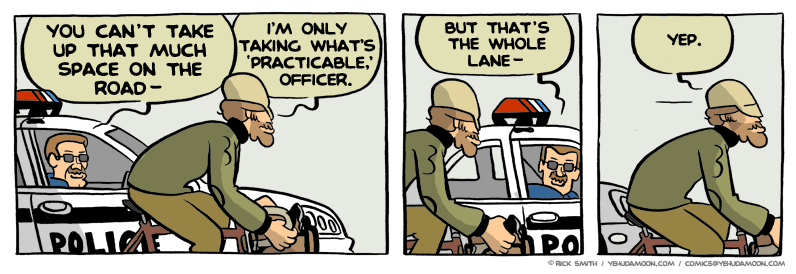
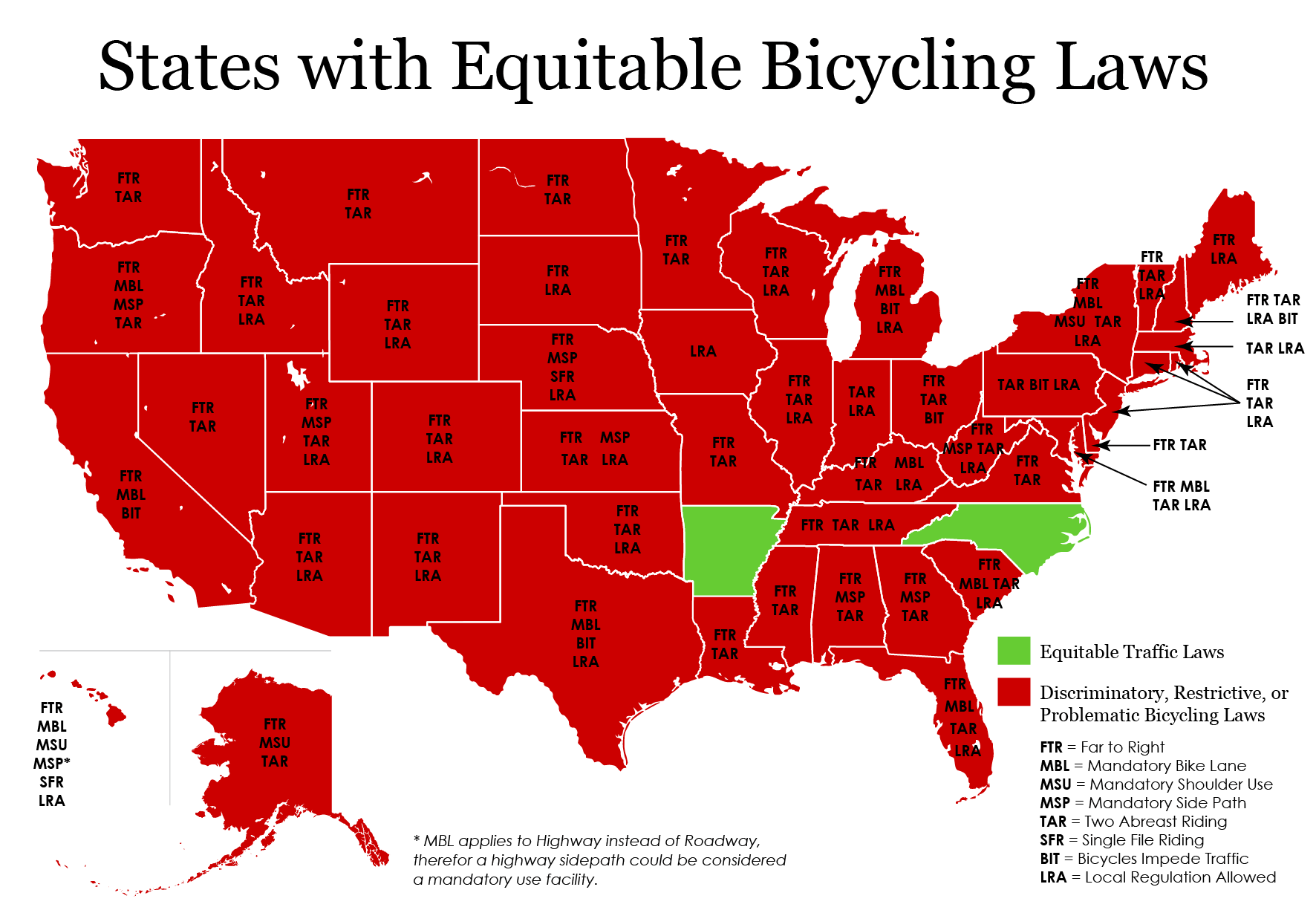
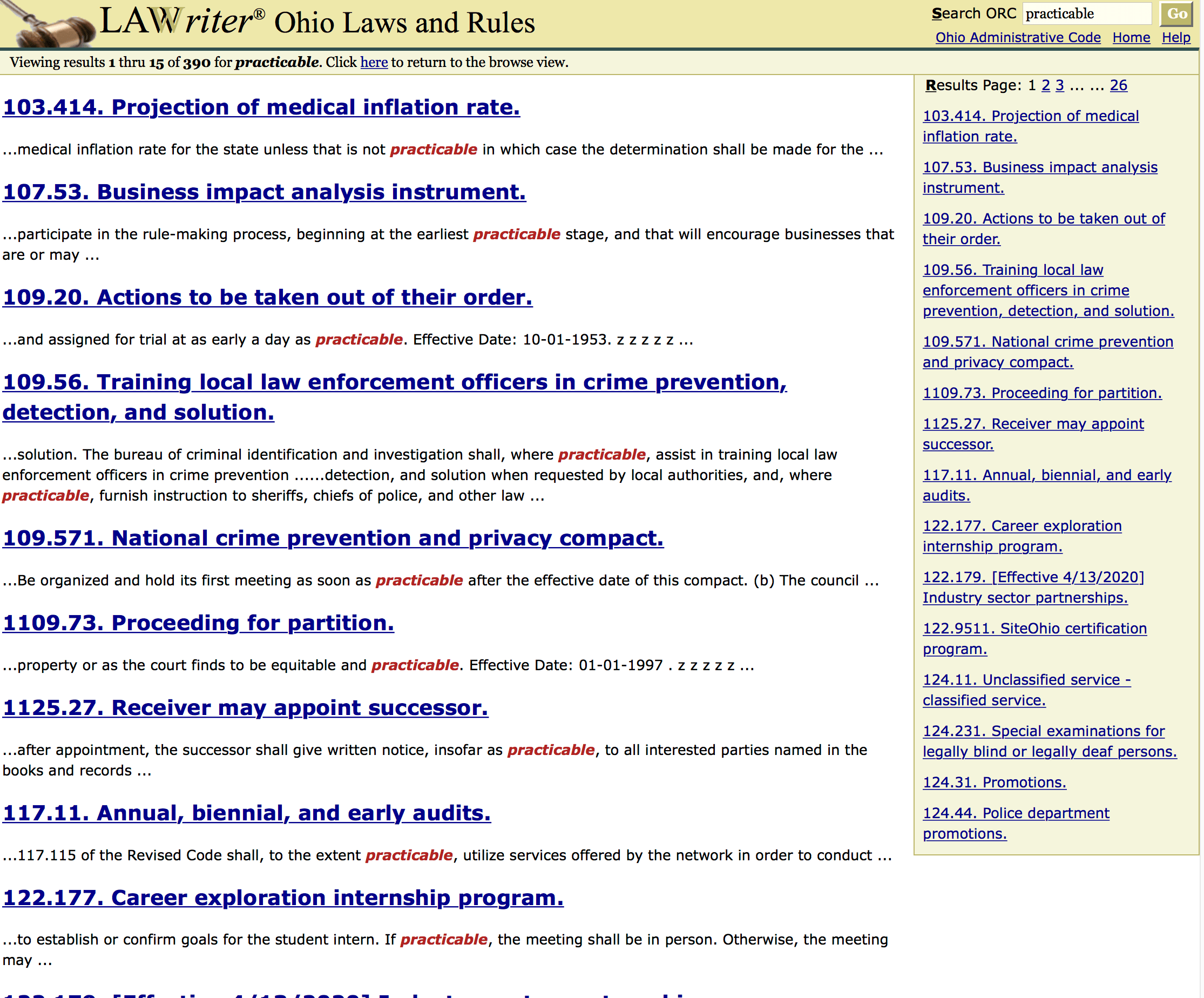
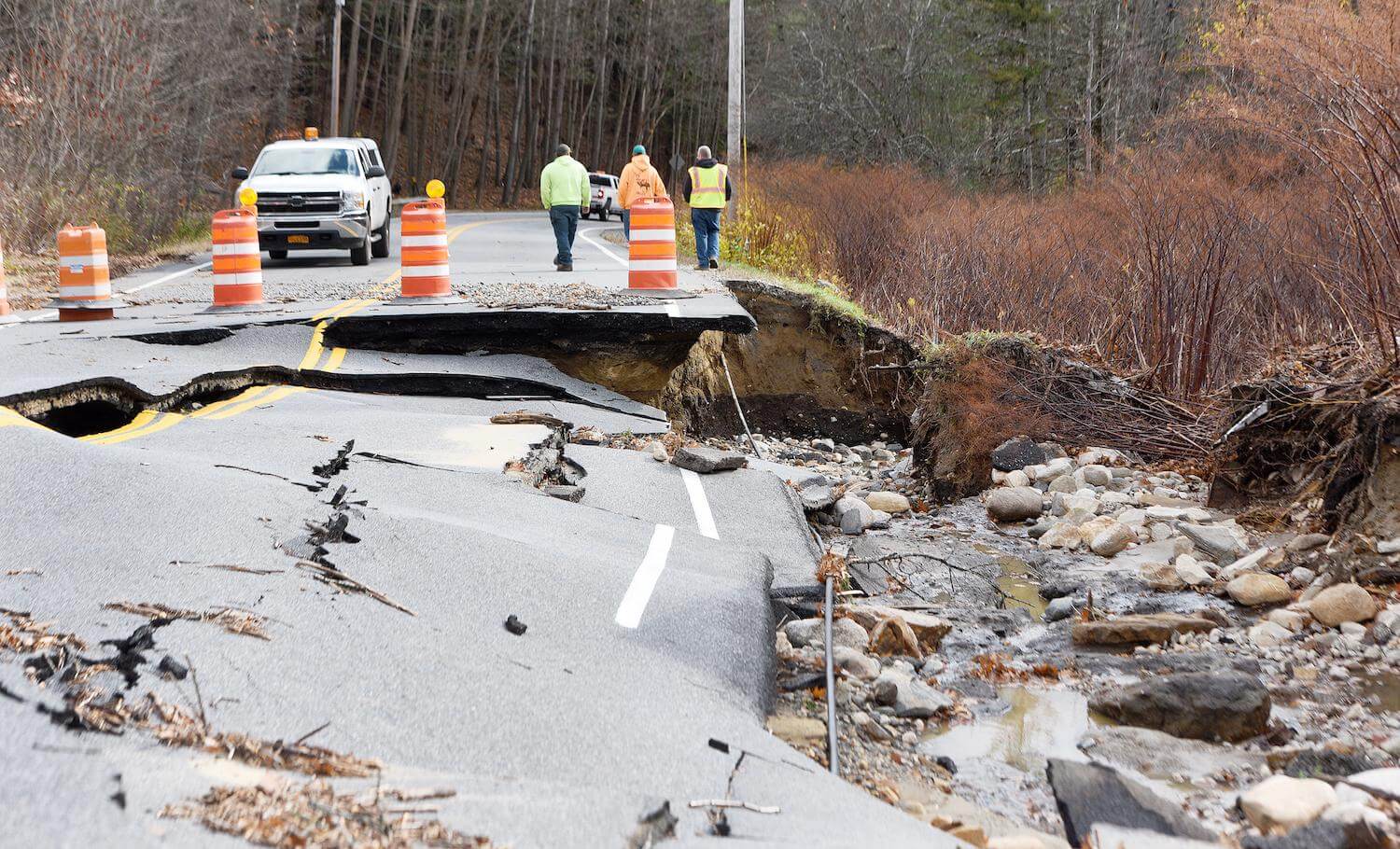
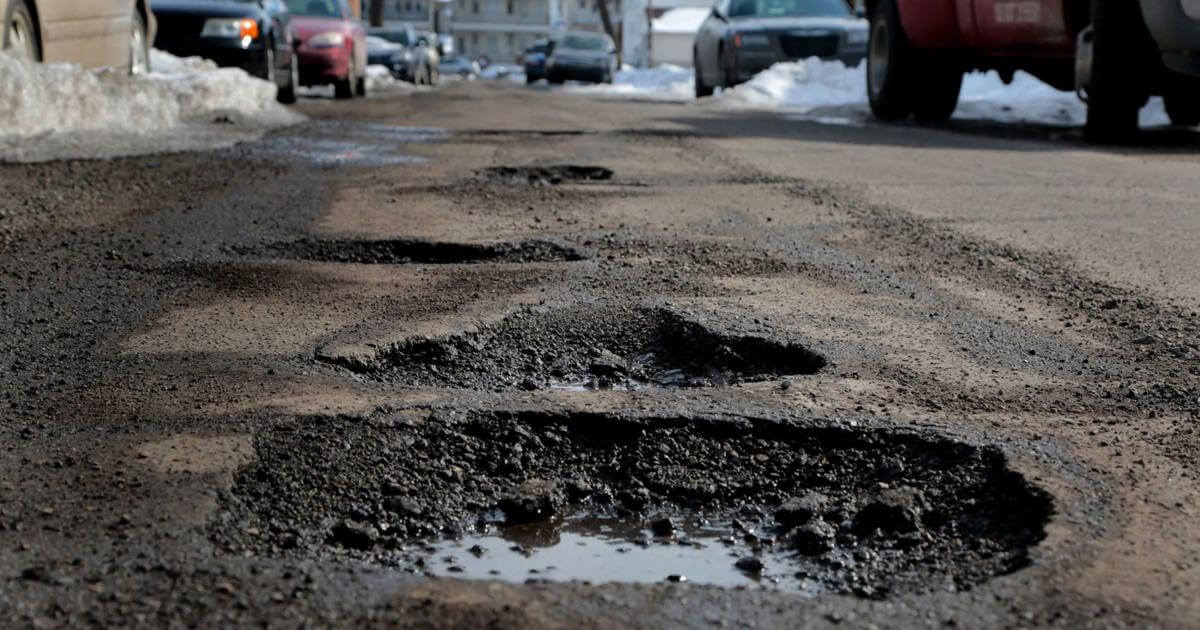
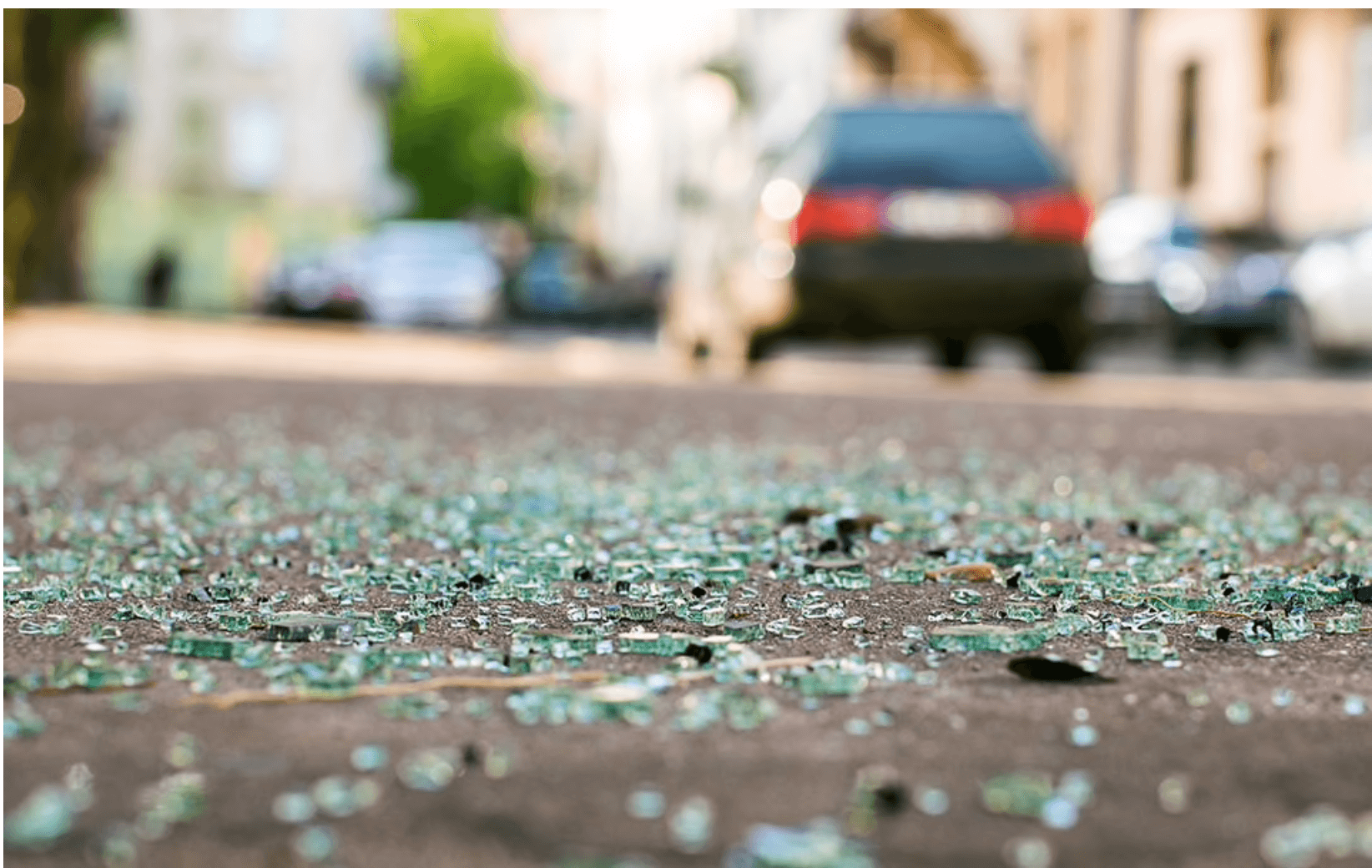
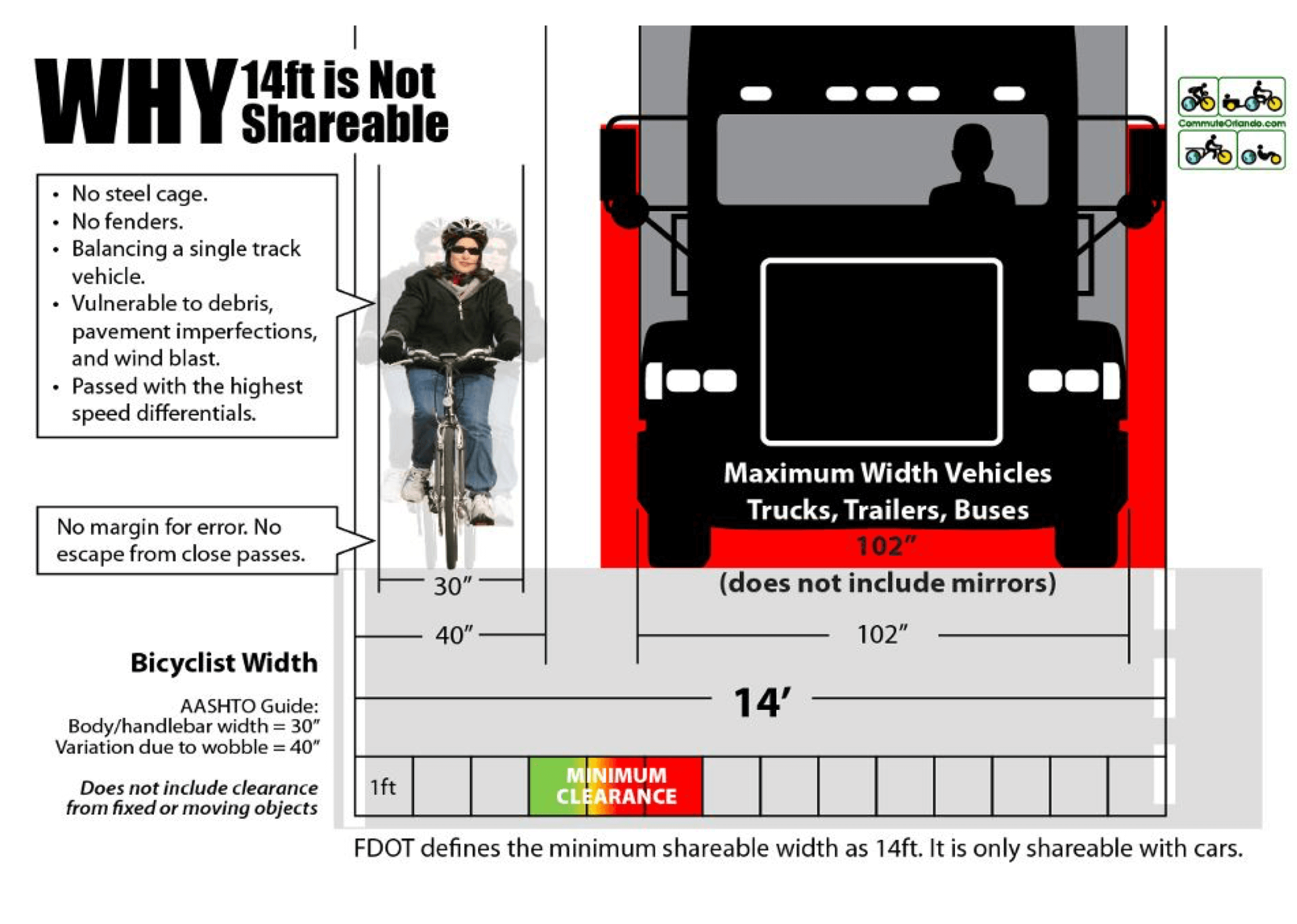
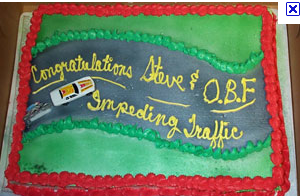
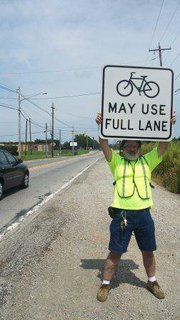
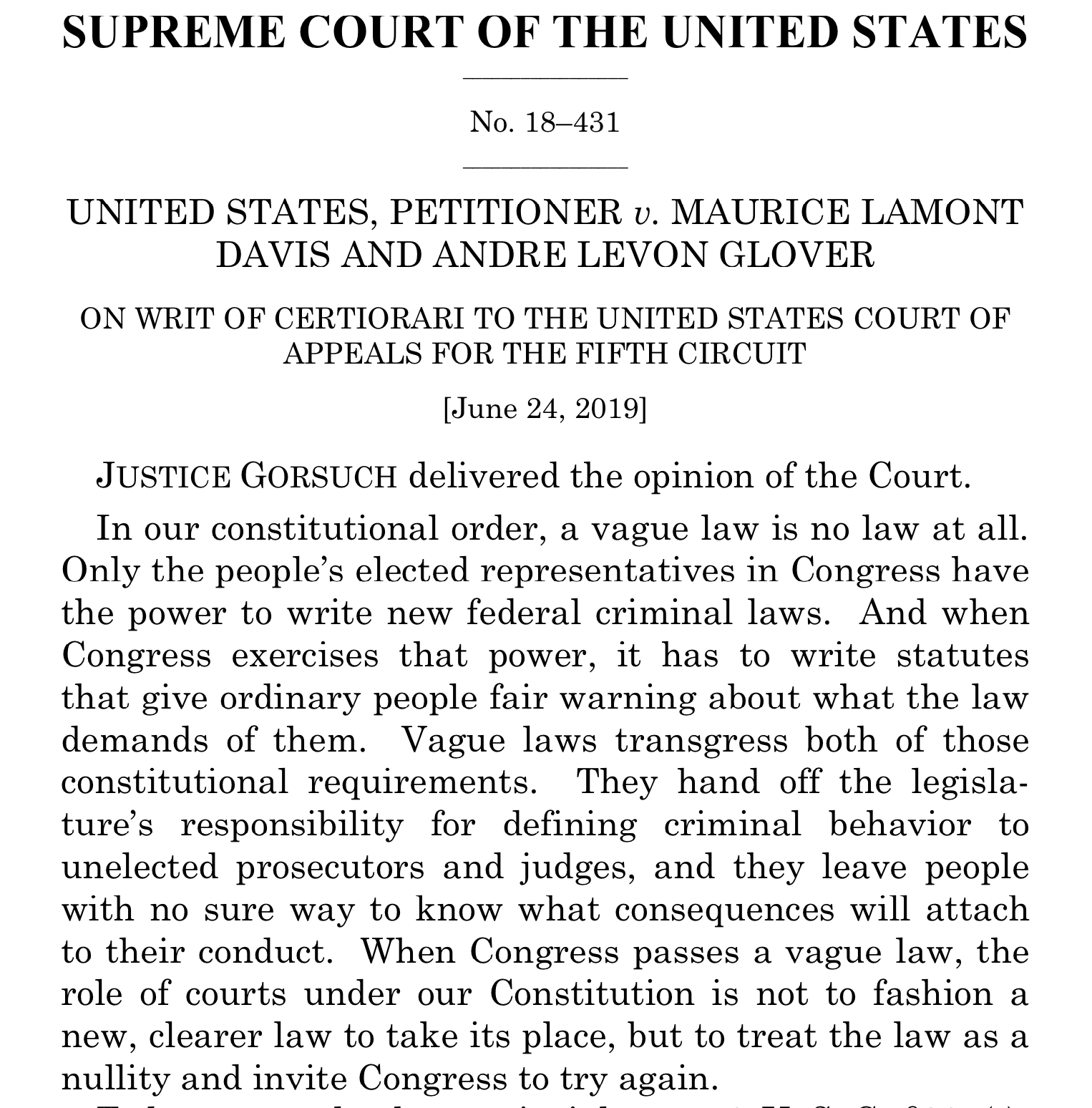
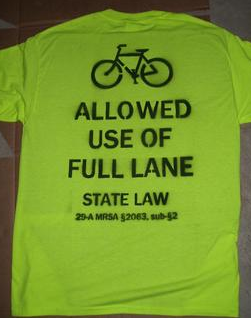
The other sign missing from narrow roads tells Ohio drivers they can cross the no-passing lines to pass bikes when it’s safe to pass.
This should focus drivers and cops on waiting until it is safe to pass in the next lane, rather than feeling trapped behind the bike by the double yellow line.
Drivers would then patiently wait to pass, as they would with any other slow moving vehicle.
——————
Here is the Ohio law:
“(A) …where overtaking and passing other traffic or driving to the left of the center or center line of the roadway would be especially hazardous and … appropriate signs or markings on the highway indicate, … every… vehicle … shall obey…. ”
[ EXCEPT ]
“(B) when all of the following apply:
“(1) The slower vehicle is proceeding at less than half the speed of the speed limit….
“(2) The faster vehicle is capable of overtaking and passing the slower vehicle without exceeding the speed limit.
“(3) There is sufficient clear sight distance [to meet safe passing laws.]”
Ohio Statutes: 4511.31
Carl – yes, this change in the “double yellow” law was included in the 2006 Better Bicycling Bill. The statute is 4511.31 and governs “hazardous zones” – the law reads as follows:
4511.31. Hazardous zones
(A) The department of transportation may determine those portions of any state highway where overtaking and passing other traffic or driving to the left of the center or center line of the roadway would be especially hazardous and may, by appropriate signs or markings on the highway, indicate the beginning and end of such zones. When such signs or markings are in place and clearly visible, every operator of a vehicle or trackless trolley shall obey the directions of the signs or markings, notwithstanding the distances set out in section 4511.30 of the Revised Code.
(B) Division (A) of this section does not apply when all of the following apply:
(1) The slower vehicle is proceeding at less than half the speed of the speed limit
applicable to that location.
(2) The faster vehicle is capable of overtaking and passing the slower vehicle without
exceeding the speed limit.
(3) There is sufficient clear sight distance to the left of the center or center line of the roadway to meet the overtaking and passing provisions of section 4511.29 of the Revised Code, considering the speed of the slower vehicle.
I have a question regarding the picture of the shirt. The State law mentioned does not appear to be Ohio or is it? If it’s not would it read this way for Ohio…
“State Law 4511.55 (C)”?
I didn’t know drivers had such a hang-up with crossing the double yellow line. They don’t seem to hesitate to cross it when moving over for vehicles stopped on the side of the road, or for passing other slow-moving vehicles. Just my experience.
In Ohio you are ALLOWED to cross the double yellow. Drivers do it without knowing it’s legal, but then argue with, or scream at, cyclists for making them do it!
Absolutely – I’ve bene arguing this for 25+ years
The town next to mine in TX did a GIS survey to find which streets merited a BMUFL sign, and discovered that there were no streets that one or more of the exceptions to TX VC 103 did not apply . They now have BMUFL signs at the city limits. I don’t know how well this has been drilled into their LEO, but I have never had a problem there.